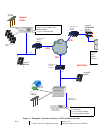
RLC
2003 Avaya Inc. All Rights Reserved.
Page 6 of 12
Local Survivable Processor S8300.doc
7.1 IP Telephones
The IP telephones perform a DHCP discovery sequence to obtain their own IP
addresses during initialization. During this dialog with the DHCP server, the IP
telephones obtain a list of the call server addresses that includes LSPs. It is
recommended that each LSP serve all the telephones within a subnet or a group of
subnets and the DHCP server should have each subnet administered with its own LSP in
the list of call server addresses.
Since the list of call server addresses is searched sequentially, any CLAN desired
for registration is listed first, followed by the LSP that is serving that subnet. When the
telephone registers with a CLAN, the telephone and the Avaya MultiVantage Software
exchange a series of messages. From these messages, the telephones are load-balanced
across CLANs in network regions. Once registered, the telephone is also given a list of
alternate CLANs within its network region that can be used in the case of a loss of
communication later.
Starting with Avaya MultiVantage Software Release 1.3 (Planned2003 release),
each network region can be assigned up to six (6) LSPs. On the SAT of the main server,
each network region will accept a list of LSPs, and that list of LSPs will be sent to the IP
phones in that network region as part of the alternate gatekeeper list. Each network
region can be defined to have multiple LSPs as backups, and each LSP can be
administered to support multiple network regions.
7.2 Avaya G700 Gateways
Avaya G700 Gateways must be administered manually through the command line
interface (CLI) of the media gateway processor (MGP). The media gateway controller
(MGC) list holds up to four (4) IP addresses. This list must be carefully configured since
it is the only list the G700 uses for recovery. There are several attributes associated with
this list that determine the behavior of the G700 Gateway during a recovery situation.
These attributes are discussed in sections 7.2.1 to 7.2.3 and behave as described in the
Avaya MultiVantage Software Release 1.3.
7.2.1 Transition Point
The transition point marks a group of IP addresses being the most important for
the Avaya G700 Gateway to reach during its search for a gatekeeper. If the transition
point is designated to be two, the G700 Gateway will attempt to contact the first two
addresses on the list for the duration of the primary search time, after which it will begin
a circular search of the entire list for the duration of the Total Search time.
7.2.2 Primary Search Time
This defines the amount of time the Avaya G700 Gateway will search the
addresses that are included in the transition point. When the G700 Gateway is searching
the addresses in the primary portion of the list (i.e., the list of addresses before the
transition point), it tries each address once and continues down the list. When it hits the
transition point, it starts again at the beginning of the list. Once the primary search time














